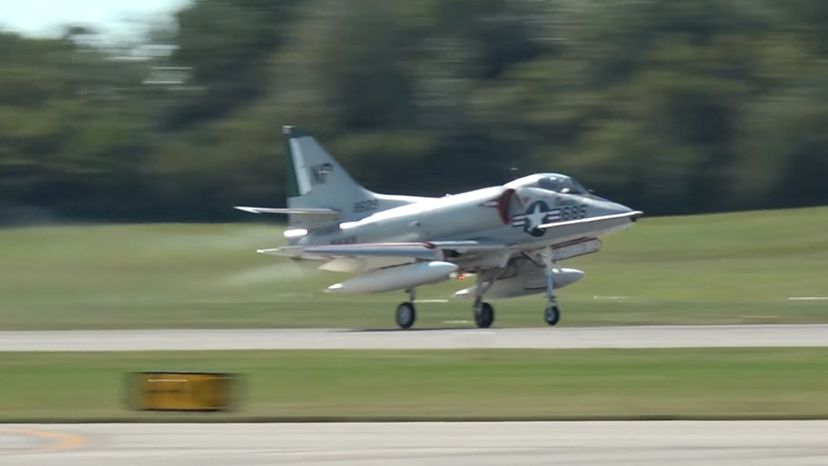
About This Quiz
Manned flight has altered the course of humanity. From breaking the sound barrier, to flying around the world on a single tank of fuel, humans have used airplanes to push the boundaries of exploration and limits of endurance.
Aerospace history is filled with jaw-dropping statistics and amazing personalities. Did you know that two different unrelated pilots with the surname, Yeager, broke separate aircraft records?
Do you know that the most mass-produced airplane in the world isn't a commercial jet? Do you know what it is? Do you know what metal you can't bring on an airplane because it might react with the aluminum?Â
Don't be surprised at the amount of fuel Boeing 747 can hold, or how wide the wingspan of a Dreamlifter cargo plane is. The cruising speed of a commercial jetliner might even surprise you! From the Wright brothers to Dick Rutan, do you know how many major historical figures were involved with bringing air travel into the modern age?
Find out how much you know about the aircraft of the world. If you're a true aircraft whiz, then this quiz should be easy!Â
The AV-8B Harrier II was the second generation of this innovative fighter family. The idea was that it could land and takeoff without a full runway, which made it more useful for the military.
It was used for electronic warfare; spying and bomb runs during the Vietnam War. They were also successfully used against armored vehicles and tanks in the Gulf War during Operation Desert Storm.
The founder of Cessna built his own plane and piloted it for the first time in 1911. The Cessna Aircraft Company was founded in 1927.
Advertisement
The Spitfire was one of the fastest fighters of the era. It wasn't actually retired from use until 1961.
The Stealth Bombers, over the course of their production, averaged over $2 billion each. They were produced from 1987-2000.
The fundamental design of the Lockheed C-130 Hercules is so solid that it has survived several makeover attempts. It has been produced for over 60 years.
Advertisement
Their maiden flight in 1903 went about 120 feet (37 meters). The plane was mainly constructed of spruce wood and muslin, and used a gasoline-powered engine.
The oxygen lasts 15 minutes. This is normally enough time to get the plane to a low-enough altitude that there is no need for additional oxygen.
You could cross America and stop only three times to refuel. Before the DC-3 you might have to stop a whopping 15 times before your journey's end.
Advertisement
At 560 miles per hour, it's no wonder that flying is so much faster than driving.
It took about three and a half hours, and the jet's maximum speed was more than 1,300 miles per hour (2,092 kilometers per hour.)
They are essentially flying computers, with their 150 miles of wiring. The weight of the wiring actually makes up an enormous part of the overall weight of an airplane, which has a lot of influence on mechanical design.
Advertisement
He topped 700 miles per hour. Unsurprisingly, the engine burned-out, and Yeager had to glide to a landing on a dry lake bed.
When two 747s collided on the runway in Tenerife, Spain, 583 people died, making it the deadliest aviation accident in history. Amazingly, 61 passengers from one of the airplanes survived.
Mercury can cause significant damage to a plane. It essentially degrades the aluminum that makes up most of the plane's structure.
Advertisement
The bulbous plane has a maximum takeoff weight of 803,001 pounds, and the interior space to accommodate huge items. The width of the fuselage is over 27 feet.
More than 25 countries have purchased F-16s. It's been in use since 1978.
It was the fastest aircraft for about 40 years. One pilot flew the plane 15,000 miles in just over 10 hours.
Advertisement
To date, the F-15 Eagle has never been defeated in aerial combat--at least the United States hasn't admitted it. A number of countries have claimed to have shot them down.
F-14 Tomcats were first exported to Iran from the U.S. back in 1976. They are still in use by the Islamic Republic of Iran Air Force.
It gets 20 percent better fuel efficiency, which is considered an evolution in commercial flight. It can hold up to 335 passengers.
Advertisement
That's 75 feet longer than the distance of the Wright brothers' first flight. The first 747 was built in 1969.
The entire U.S. fleet was grounded temporarily until Boeing fixed the battery-fire issue. They were grounded for almost half a year in 2013.
The North American X-15 hit more than 4,200 miles per hour, which is about Mach 6.7. It obtained maximum speed on October 3, 1967, while piloted by William J. "Pete" Knight.
Advertisement
The whole-plane parachutes are credited with saving nearly 400 lives as of February 2018. They were first deployed in 1983.
The tanks are so large, that a full-grown man can walk and crawl inside of them.
Boeing spent about $30 billion. In spite of production delays, the aircraft has been snapped up by airline companies.
Advertisement
Believe it or not, the survivability is around 95%--and sitting near the rear of the plane yields higher rates of survival than sitting in the first few rows.
The 1986 trip covered more than 25,000 miles (40,234 kilometers) and took nine days. It was piloted by Dick Rutan and Jeana Yeager (amazingly, of no relation to Chuck Yeager!)
More than 40,000 have been sold since 1956. Cessna 172s are the most popular aircraft in aviation history.
Advertisement